National Gallery of History and Art in Washington Dc
National Gallery History
Establishing the Museum
The National Gallery of Art was conceived and given to the people of the United states of america by Andrew Due west. Mellon, a financier and art collector who served as secretary of the treasury nether 4 presidents from 1921 to 1932. During his years equally a public servant, Mellon came to believe that the United States should have a world-course national art museum comparable to those of other nations. In 1936 Mellon wrote to President Franklin D. Roosevelt to offer his gift of paintings and sculpture for a new museum in Washington, DC, that he would build and finance with his own funds. Roosevelt endorsed Mellon's offer, and Congress accepted his gift in 1937.
Explore a detailed timeline of our history.
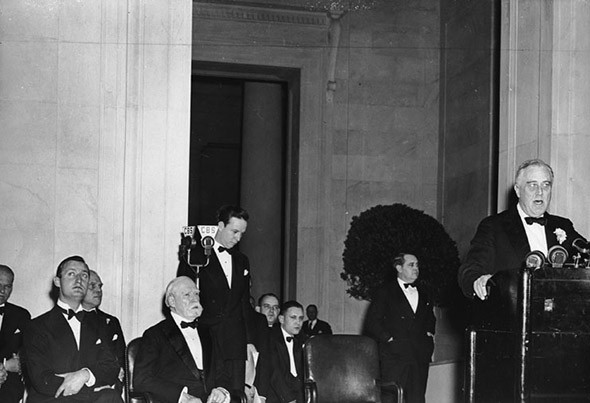
President Franklin D. Roosevelt speaking at the dedication of the National Gallery of Art, March 17, 1941. National Gallery of Art, Gallery Archives.
Construction of the Westward Building
Mellon selected American architect John Russell Pope (1874–1937) to design the building for the new museum. Now called the Due west Building, it was designed in a neoclassical style that mirrors elements of Pope'south designs for the nearby National Archives building and the Thomas Jefferson Memorial. The exterior was synthetic with Tennessee pink marble, and Pope specified that skylights should cover most the entire 3-acre roof to illuminate and unite the galleries.
Mellon and Pope died inside 24 hours of each other in Baronial 1937, non long after excavation for the West Building's foundations had begun, but the museum was built according to their concepts. The National Gallery was dedicated on March 17, 1941, with Paul Mellon presenting the museum on behalf of his begetter to President Roosevelt, who accustomed the gift for the nation.
"The dedication of this Gallery to a living past, and to a greater and more richly living time to come, is the measure of the earnestness of our intention: that the freedom of the human spirit shall go along."
– President Franklin D. Roosevelt at the dedication of the National Gallery of Art, March 17, 1941. Listen to the full speech communication.
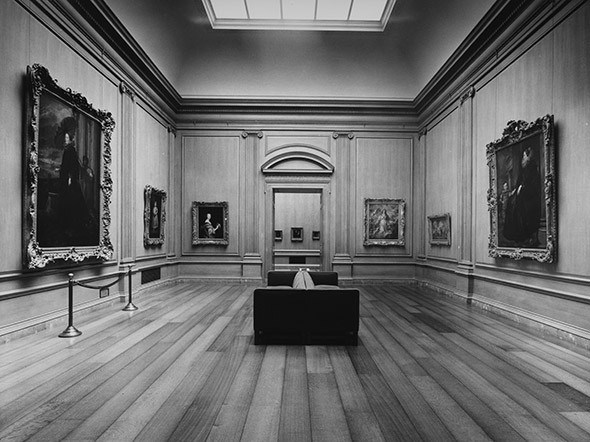
The Westward Edifice'due south Gallery 43 in 1941. National Gallery of Fine art, Gallery Athenaeum
Creating the Drove
When the National Gallery opened to the public, the nucleus of its world-grade collection was 126 paintings and 26 sculptures given by Andrew Mellon—from Raphael'sAlba Madonnato Francisco de Goya'sMarquesa de Pontejos and Giovanni Bologna'sMercury, which currently adorns the central fountain in the Rotunda. Mellon insisted that the museum not bear his proper name, believing that information technology should be a truly national institution and knowing that it would depend on generous gifts of art from many individuals to make full its spacious galleries. The National Gallery became a "collection of collections" thanks to the generosity of founding benefactors Samuel H. Kress, Rush Kress, P. A. B. Widener, Joseph Widener, Lessing J. Rosenwald, Chester Dale, Ailsa Mellon Bruce, and Paul Mellon.
In the years since Andrew Mellon's first souvenir, the National Gallery'south collection has grown to more than than 150,000 works thank you to the generosity of other individuals and foundations.
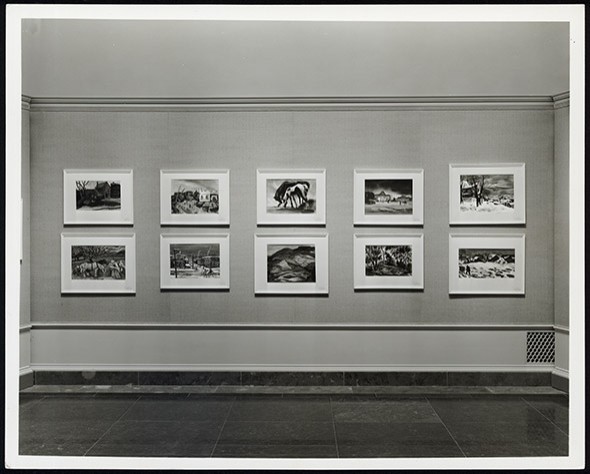
Two Hundred American Watercolors was the National Gallery'southward starting time loan exhibition and was on view from May 15–June 4, 1941.
Fulfilling the Mission: Public Programming
In the National Gallery's dedication, President Roosevelt referred to the Gallery as "a living establishment . . . dedicated forever . . . to the use and enjoyment of the people of the United states of america." To fulfill this obligation, the National Gallery established programs in its first yr that have delighted visitors ever since.
The first temporary loan exhibition was held merely two months after the museum opened. Hundreds of succeeding exhibitions have enabled the museum to brandish art from a wider range of cultures and fourth dimension periods than are represented in the permanent drove.
A horticultural department, responsible for maintaining the National Gallery's indoor and outdoor gardens, curates stunning displays of plants and flowers throughout the year—most famously the rotating Rotunda installations on view from mid-November through April.
Daily public tours and weekly lectures take been offered since the National Gallery's opening, and in 1942 the National Gallery established a motion picture program and a free Sunday evening concert series—the oldest, continuous series in the city. Public programs have since expanded to include a wide array of free educational programs and resources for visitors, teachers, and students.
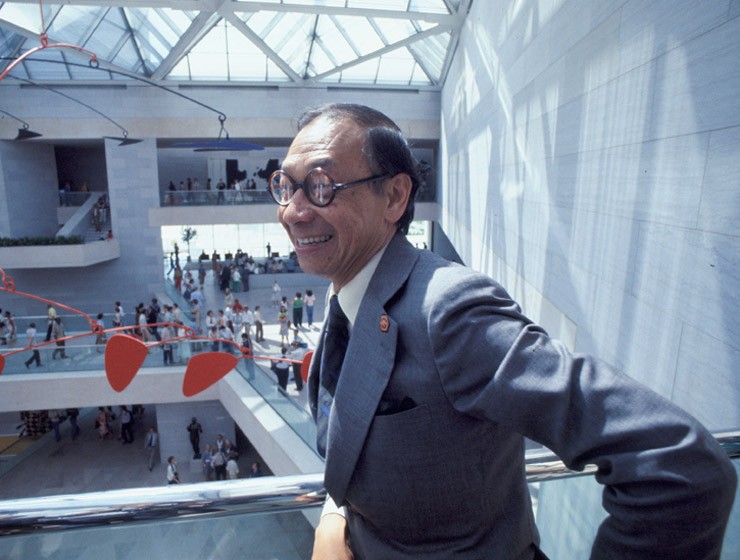
Architect I. M. Pei in the E Building of the National Gallery of Art on opening 24-hour interval, June 1, 1978. © Dennis Brack/Black Star. National Gallery of Art, Washington, Gallery Archives. Mind to audio of an oral history interview with I. Grand. Pei, conducted in 1993.
Expanding the Mission: Construction of the E Building
Andrew Mellon anticipated that the National Gallery would grow beyond the capacity of its original edifice, and, at his request, Congress set aside an adjacent plot of land for future use when it first established the National Gallery. Plans for expansion were forming past the museum's 25th ceremony in 1966, because virtually of its original galleries were filled and there was a desire to create a library and an advanced research eye.
In 1967 Andrew Mellon's children, Paul Mellon and Ailsa Mellon Bruce, offered funds for a second edifice, and architect I. Grand. Pei (1917–2019) was selected to blueprint it. The modernist construction he conceived was inspired and informed past its trapezoidal site, located between Pennsylvania Avenue and the National Mall and between Tertiary and Fourth Streets NW. To accommodate the unusual shape of the plot, Pei designed the East Building as two triangles—1 to agree a library, offices, and community of scholars, and the other as public gallery space for the permanent collection and exhibitions. Pei linked his design to the neoclassical design of John Russell Pope by calling for the exterior to be clad in the same Tennessee pink marble used for the West Building.
Structure of the East Edifice began in 1971, and as workmen labored to realize Pei'south ambitious blueprint, a newly founded Collectors Commission deputed artists such as Henry Moore and Alexander Calder to create works for the E Building. This committee has fabricated annual gifts of modernistic art to the National Gallery ever since, including works by Joan Miró, Louise Bourgeois, Yayoi Kusama, Tony Smith, and others.
On June 1, 1978, Paul Mellon and President Jimmy Carter dedicated the new museum to the people of the Usa. With the East Building opening, the National Gallery's vision for a enquiry center was realized in both the expansion of the Library every bit well as the creation of the Center for Avant-garde Report in the Visual Arts. The Center continues to build a network of scholars enhancing the understanding of art and architecture through professorships, fellowships, symposia, and publications, while the Library supports the academic community at large.
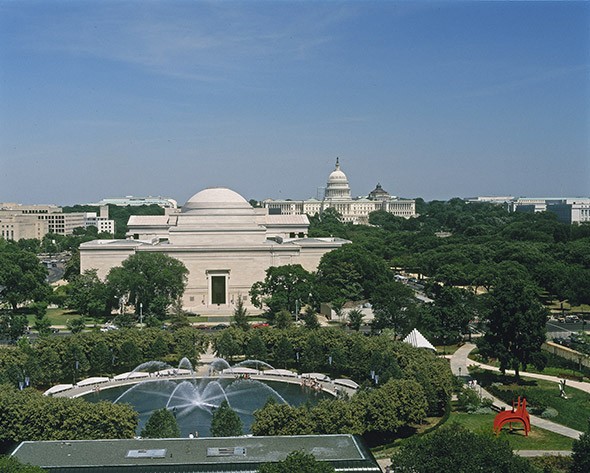
The National Gallery of Art Sculpture Garden created a 6.i-acre oasis for outdoor sculpture.
Construction of the National Gallery of Art Sculpture Garden
The concept of the National Gallery of Art Sculpture Garden dates to the 1790s, when Pierre Fifty'Enfant called for a public, landscaped garden in his primary plan for the nation's new capital. The Sculpture Garden'southward six-acre plot betwixt 7th and 9th Streets NW was controlled by the National Park Service until 1966, when they signed an agreement with the National Gallery to interact on its utilize.
By the time full jurisdiction was officially transferred to the National Gallery in 1991, the Park Service had added a central, circular pool that was used as an water ice rink in winter every bit well as an art nouveau-inspired pavilion and ring of linden trees. With generous support from the Morris and Gwendolyn Cafritz Foundation, the National Gallery employed distinguished landscape builder Laurie D. Olin to refresh the garden'due south design while honoring the existing key features. One time once again, Tennessee pink marble was employed to create a visual thread through the entire National Gallery campus.
The National Gallery of Art Sculpture Garden opened to the public on May 23, 1999. First Lady Hillary Rodham Clinton accepted the gift of the completed garden on behalf of the nation.
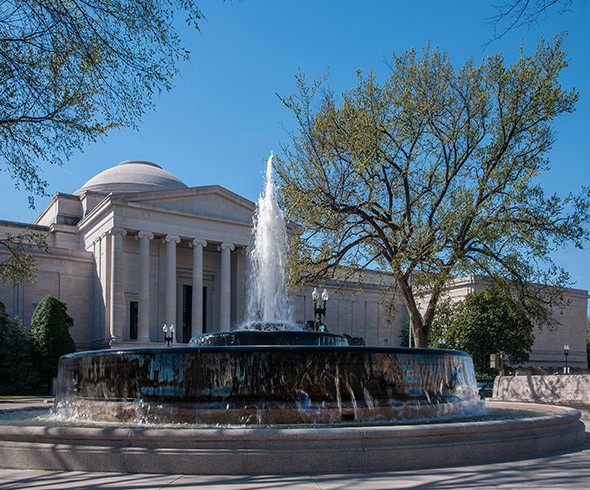
Andrew Westward. Mellon Memorial Fountain, National Gallery of Art, Washington
Completing the Campus: The Andrew W. Mellon Memorial Fountain
Another agreement with the National Park Service transferred custody of the Andrew Due west. Mellon Memorial Fountain and surrounding triangular park to the National Gallery in 2015. The fountain, completed in 1952 and located merely north of the National Gallery's Due west Building, honors Andrew West. Mellon's legacy not just equally the founder of the National Gallery, merely also as the secretarial assistant of the treasury who advocated for the construction of the abutting Federal Triangle. When the central bronze fountain was synthetic, it was thought to be the largest in the world.
The National Gallery's collection, its public programs, and its contributions to the study of visual arts continue to grow thanks to the efforts of endless supporters, staff, and other advocates who believe, every bit President Roosevelt declared, that "neat works of art…are so clearly the holding not of their unmarried owners but…of all who love them."
For additional information and resource on National Gallery history, visit the National Gallery Athenaeum.
You May As well Like
Source: https://www.nga.gov/about/gallery-history.html